Once the temporary ego-swelling had subsided, of course, I had to make some decisions. My friend (hello, Ms. Friend! ;D) and her mother are both allergic to wool, so anything but wool would work. Well, I have plenty of alpaca fleeces, so off I went to the stash.
I wanted to pick a fiber good for dyeing, since alpaca doesn't naturally come in blue, green, or purple, the colors I hear Ms. Friend's mom uses the most. ;) This, a fleece from Calypso Farm, from a Suri alpaca named Glass Slipper, seemed perfect:
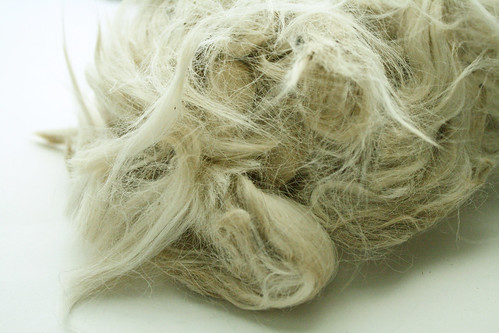
Suri, by the way, is a rare breed of alpaca known for having silky, warm, lustrous, drapey fiber. Only one percent of the alpacas on the planet are of the Suri breed, so "rare" isn't just hype! ;) (Check out Suri Network for more information on Suri alpacas and Suri fiber specifically.)
So the fleece visited the wash tub and the dye pot, and voila! Oceany alpaca!
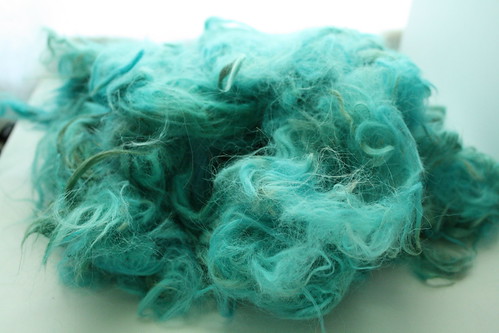
Anyway, originally I thought I'd do a lightweight yarn that might work for knitting a shawl, as Ms. Friend mentioned something about a lace book for her mom. Now, maybe you know this already because you have lots of friends who are fibers, but fibers have preferences about what makes them look good and behave well. Some look good in little black dresses, some look good in jeans and a t-shirt — well, okay, I'm really talking about fiber preparation here, like combing vs. carding, but I am so not in a jargony technical mood today, so we'll pretend it's kind of like clothing style. ;)
Point is, since I hadn't worked with this particular fleece before and didn't know its preferences, I experimented with different fiber preparations. I tried preparing it on my hand cards, on my drum carder, and with my hand combs, and I tried spinning yarn from all these preparations as well as spinning the fiber straight from the cloud (meaning without doing more than picking it apart with my fingers a bit).
Some of the results I won't share with you *cough*, but I found that while the different preparations weren't radically different in results, the different processes were different amounts of pain in the butt. ;) (Suri alpaca doesn't look fluffy until you try to run it through a Louet Junior Roving Carder, let me tell you ... and then it flies everywhere. I guess I need a drum carder with finer teeth? Or maybe I need to buckle down and get those cotton hand cards I've been drooling over for years.) Anyway, in the end I end I went with the hand combs — even though I think of them as fairly slow, they seem suited to the Suri's straight, silky fibers ... and they don't make the fiber fly everywhere and stick to everything. ;)

Scary fiber equipment, yay!
I even knit up some of the sample yarn to see how it behaved.
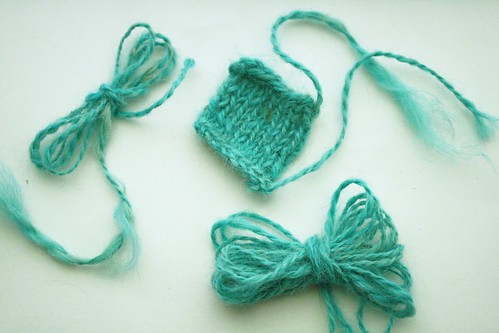
That looks pretty decent, huh? But like I said, different fibers have different preferences, and there was just something about this preparation that didn't seem ideal. Sure, it was functional, but the Suri seemed like it wanted to show off a little more, and not be so traditional. Lots of fibers do traditional perfectly well, and the Suri does have an interesting halo to it when spun like this, but ... well, at the rate I was spinning, it also would have taken me forever and ever to finish the whole batch of fiber at that weight. And I had this possibly odd idea that a Mother's Day gift should probably be ready before Mother's Day, plus, I didn't want to think about pricing a yarn that takes 9 whole hours to spin, not even counting the combing and the dyeing and the washing and, and...
So I decided I'd spin it fatter, since the fatter yarn sample I did seemed to show off the Suri's qualities better. Then I thought again: If I spun it fat, because alpaca tends to be fairly heavy and dense compared to wool, I'd end up with a fat, short skein of yarn, an amount that would make it more of an accent yarn than something Ms. Friend's mom would be able to knit a whole item out of. And that'd be silly, wouldn't it? But the singles alone, with its decent yardage, didn't seem appealing enough — again, it was functional, but I wanted to do something special, not just a plain ol' singles.
Then I remembered thread-plying! And so I went into the part of the stash with the cones of vintage weaving yarn, and I pulled out some white thread, and went to town. Ply, ply you fools! The result:
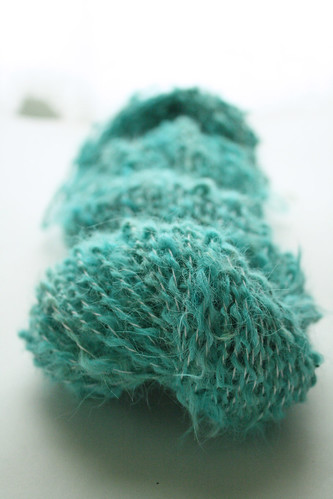
Ta-da! A little over 100 yards of thread-plied art yarn. (Okay, it's a slightly sedate art yarn, but I didn't want to force anything too wacky on someone I can't remember meeting in person, meaning where she would be in range of my ability to sense wackiness tolerance. ;))
Yeah, I may have fallen victim to making things more complicated than they needed to be, by following my own preferences and treating this project like I would have had it been a present for my mom, but that's not such a horrible thing to do when you're given free rein to make whatever yarn you like, right?
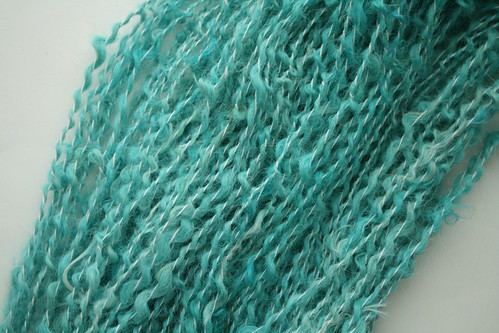
And hey, if the recipient hates it, or if she happens to see this blog post and decides she likes it the traditional, takes-two-gazillion-years-to-spin yarn better than the arty yarn, I do have more of this fiber, and more dye. I can always call a redo! It may even take me slightly less than a gazillion years to spin it next time, since then I'll have had the practice of spinning it this time around. ;)
Of course, I do hope she ends up liking it, maybe even making something out of it that eventually shows up in my inbox in photographic form. That's one of the coolest things that can happen to your handmade stuff — seeing it in happy use, in action.
So here's hoping it's well-received. :D Meantime, I'm off again. There's still more of that gigantic scarf to knit...
